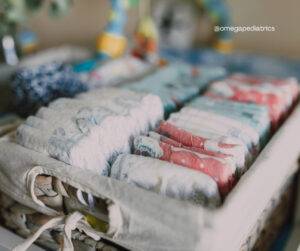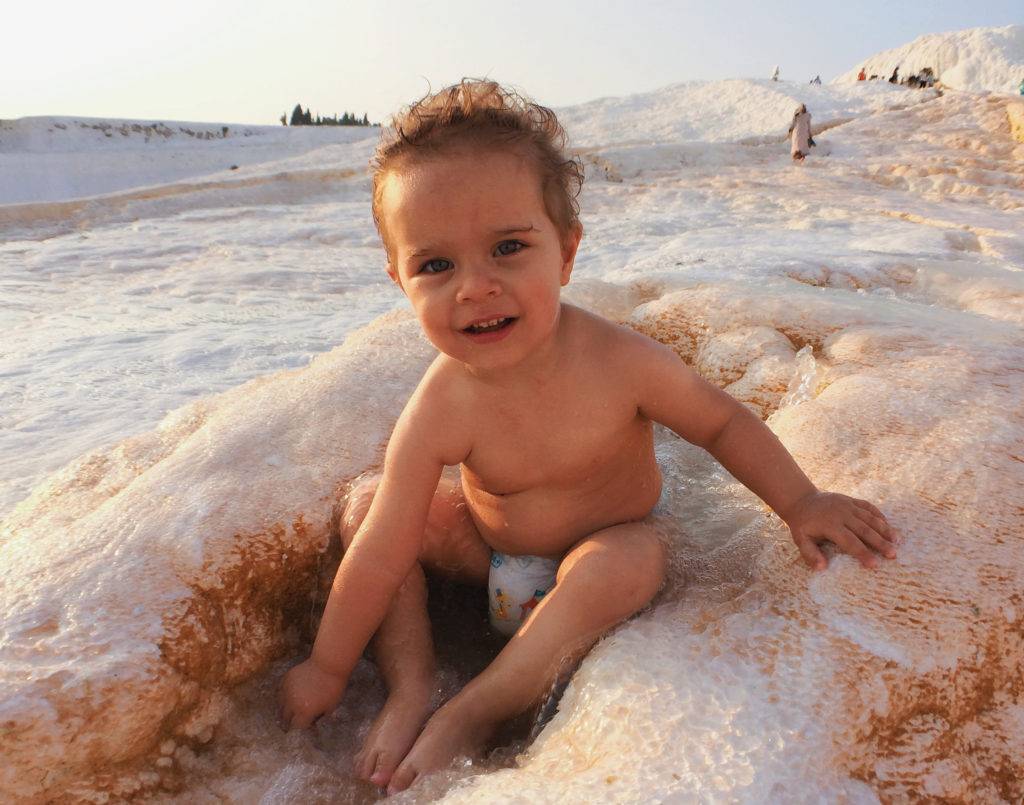Table of Contents
Comprehensive Guide to Understanding and Managing Diaper Rash (Diaper Dermatitis)
Diaper dermatitis, commonly known as diaper rash, is a frequent concern for parents and caregivers. This skin irritation occurs in the diaper area due to prolonged contact with urine and feces. Although diaper rash is usually easily treated, there are instances when it can become complicated and require medical intervention. Understanding the various types and symptoms of diaper dermatitis, along with preventive measures, is crucial for ensuring your baby’s comfort and health.

What is Diaper Dermatitis?
Diaper dermatitis is an inflammation of the skin that occurs under the diaper area. It is primarily caused by prolonged exposure to moisture, urine, and feces, which can irritate the sensitive skin of infants. While most cases of diaper rash are mild and can be treated at home, certain situations necessitate medical attention.
Common Causes of Diaper Dermatitis
- Diaper rash is primarily caused by prolonged exposure to moisture, urine, and feces, which can irritate the sensitive skin of infants. Certain situations, such as the use of antibiotics or exposure to chemical irritants in disposable diapers, wipes, or detergents, can also contribute to the development of diaper rash. However, there are many different factors that can lead to diaper rash, including:
- Too much moisture: When your baby’s diaper area stays wet for too long, the skin starts to break down.
- Chafing or rubbing: Known as intertrigo, this occurs in the diaper area, where friction can damage the skin.
- Prolonged contact with pee or poop: Extended exposure can irritate your baby’s skin.
- Infections: Both yeast and bacterial infections can cause diaper rash.
- Allergic reactions: Sensitivity to the materials in diapers can trigger a rash.
- Food allergies: Certain foods might cause allergic reactions that lead to diaper rash.
- When the skin remains wet for extended periods, it becomes more prone to damage. Rubbing wet skin exacerbates the issue, making it easier for moisture from a soiled diaper to harm your baby’s skin. This creates an environment where a diaper rash can easily develop. By understanding these various causes, you can take steps to prevent diaper rash and keep your baby’s skin healthy and comfortable.

Recognizing Complicated Diaper Rash
While mild diaper rash is common, certain types require medical intervention. Below are five variants of complicated diaper rash that need prompt medical attention.
1. Candida Diaper Dermatitis
Candida diaper dermatitis is a fungal infection characterized by red, beefy plaques of skin. Key features include:
- Beefy Red Plaques: Raised areas of red skin, often with satellite lesions.
- Superficial Pustules: Small pustules that appear pus-filled.
- Satellite Lesions: Small, isolated spots away from the main rash area.
This type of rash typically follows a chemical diaper dermatitis and involves skin folds. Diagnosis is clinical but can be confirmed with a laboratory test. Treatment involves topical antifungal creams. Persistent infections may indicate underlying conditions like Type 1 diabetes or chronic mucocutaneous candidiasis.
2. Impetigo from Staphylococcus aureus
Impetigo is a bacterial infection that can complicate a diaper rash. It presents as:
- Honey Crusts: Fragile lesions that look like honey when eroded.
- Bullous Impetigo: Larger lesions that rupture easily, often seen in more severe cases.
Diagnosis is confirmed through lab tests of the pus. Treatment includes antibiotics, and infants under two months may require hospitalization due to the risk of septicemia.
3. Perianal Excoriation from Streptococcus
Perianal excoriation due to group A streptococcus infection presents with:
- Sharp Demarcated Redness: Red and inflamed areas around the anal opening.
- Perirectal Fissures: Painful cracks in the skin that may cause blood-streaked stools.
This condition requires antibiotics and thorough examination. It should resolve within 14 to 21 days with proper treatment.
4. Staphylococcal Scalded Skin Syndrome
Staphylococcal scalded skin syndrome is a severe staph infection that causes:
- Peeling Skin: Large areas of skin peel away, resembling a scald.
- Fever: Accompanied by systemic symptoms like fever.
Warm compresses can alleviate discomfort, but medical treatment is essential.
5. Herpes Simplex Virus Infection
Herpes simplex virus (HSV) infection in infants manifests as:
- Vesicles, Papules, or Pustules: Small fluid-filled lesions.
- Potential Indicator of Abuse: HSV in infants can indicate sexual abuse and requires immediate investigation.
Treatment involves antiviral agents, but ensuring the child’s safety is paramount.
Understanding Other Common Skin Conditions in Babies
In addition to diaper rash, several other skin conditions can affect infants. Recognizing these conditions helps in differentiating and managing them effectively.
Yeast Infection
Yeast infections thrive in warm, moist environments like skin folds. They appear as:
- Swollen, Red Rash: With white scaling and lesions.
- Satellite Lesions: Small white spots surrounded by red skin, often spreading to the thighs and abdomen.
Preventive Tips
- Keep the Diaper Area Dry and Clean: Change diapers frequently and ensure the skin is dry.
- Use Barrier Creams: Zinc oxide creams can protect the skin from moisture.
Psoriasis
Psoriasis in babies is rare but identifiable by:
- Red, Thickened Skin: With silvery white scales.
- Location: Often found on legs, arms, or scalp.
Impetigo
As previously mentioned, impetigo presents with:
- Yellowish-Brown Crusty Patches: And/or pus-filled blisters.
- Rapid Spread: This condition is highly contagious.
When to Seek Medical Advice
Contact your pediatrician if:
- Symptoms Persist: If the rash lasts more than a week.
- Condition Recurs: After initial healing.
- Severe Symptoms: Such as extensive redness, swelling, or signs of infection.
What are the best steps to preventing diaper rash?
Preventing diaper rash is essential for your baby’s comfort. Here are practical steps to implement:
Keep the Diaper Area Dry and Clean
- Frequent Diaper Changes: Change diapers promptly to avoid prolonged exposure to moisture.
- Thorough Cleaning: Ensure the diaper area is clean and dry before putting on a new diaper.
Choose the Right Diaper
- Proper Fit: Ensure the diaper fits well to avoid skin irritation.
- Experiment with Brands: Find a brand that suits your baby’s skin.
Use Barrier Creams
- Zinc Oxide Creams: Apply a thin layer during each diaper change to protect the skin.
Allow Skin to Breathe
- Diaper-Free Time: Let your baby go without a diaper for short periods to allow the skin to air out.
Wash Your Hands
- Prevent Bacteria Spread: Always wash your hands before and after changing diapers.
Diaper Rash Evaluation Guide
Understanding the symptoms of diaper rash at various stages helps in determining the appropriate care or when to seek medical advice.
Slight Diaper Rash
- Faint Pinkness: Mildest form, with occasional small raised bumps.
- Minor Dryness: Possible dryness of the skin.
Mild Diaper Rash
- Definite Pinkness: In some spots, with small areas of deeper red.
- Scattered Papules: Small raised bumps.
- Moderate Dryness: Or scaling.
Mild to Moderate Diaper Rash
- Expanded Pinkness: Covering more skin.
- Intensified Red Patches: Within the pink areas.
- Increased Papules: And moderate scaling.
Moderate Diaper Rash
- Distinct Redness: Over a larger area.
- Concentrated Red Spots: With groupings of papules, some fluid-filled.
- Slight Peeling and Swelling: May occur.
Severe Diaper Rash
- Widespread Redness: Intense and extensive.
- Severe Symptoms: Pronounced peeling, significant swelling, and possible bleeding.
- Loss of Outer Skin Layer: With extensive areas of papules and pustules.
Understanding Various Baby Rashes Beyond Diaper Rash
Distinguishing between diaper rash and other skin conditions is essential for appropriate treatment.
Candida Diaper Dermatitis
Characterized by:
- Red, Beefy Raised Areas: Known as plaques.
- Superficial Pustules: Pus-filled spots.
- Satellite Lesions: Spots away from the main rash area.
Management and Prevention
- Maintain Dryness and Cleanliness: Frequent diaper changes and keeping the skin dry.
- Consult Pediatrician: If symptoms persist, for antifungal treatments.
Impetigo from Staphylococcus aureus
Impetigo as a secondary infection presents as:
- Yellow-Brownish Crusts: Or pus-filled blisters.
Prompt Treatment
- Start Treatment Quickly: Contact your pediatrician for antibiotics.
Perianal Excoriation from Streptococcus
Characterized by:
- Severe Irritation: Around the anal area.
- Painful Skin Breakdown: Leading to fissures.
Staphylococcal Scalded Skin Syndrome
A severe condition marked by:
- Peeling Skin: Resembling a scald.
- Systemic Symptoms: Like fever.
Herpes Simplex Virus Infection
Presents as:
- Vesicles, Papules, or Pustules: Small fluid-filled lesions.
- Potential Indicator of Abuse: Requires immediate investigation.
Consultation with Healthcare Providers
Seek advice from a pediatrician if:
- Typical Treatments Fail: Symptoms do not resolve.
- Signs of Infection: Are present.
Conclusion
Diaper dermatitis is a common yet manageable condition. Recognizing the various types and symptoms, understanding preventive measures, and knowing when to seek medical attention are crucial for ensuring your baby’s comfort and health. By following these guidelines, parents and caregivers can effectively manage diaper rash and other skin conditions, providing the best care for their infants.
Call to Action
If you notice any unusual symptoms or persistent rashes in your baby, do not hesitate to consult your pediatrician. Early intervention can prevent complications and ensure your baby’s skin remains healthy and comfortable. For more tips and advice on infant care, subscribe to our newsletter and stay informed on the latest in pediatric health.
Here at Omega Pediatrics we ensure that parents have access at all times so that they can reach us for decisions about their child’s health. Read other blog posts here.
What have you experienced with diaper rash? Please comment below and feel free to share this blog post.
Comment below or on our Facebook Page. Please share this article.
Omega Pediatrics Difference: At Omega Pediatrics in Roswell, Georgia we understand the challenges that parents face when their children develop symptoms late in the day or after hours. Many pediatric offices are closed after 4 pm however we are open every weekday up to 9 pm for walk-ins and we have telemedicine via e-visits for our known patients. Our clinic is one of the easily accessible pediatric primary care clinics in Roswell and Alpharetta. We provide pediatric primary care to families in the North Fulton area and we have families that live in Sandy Springs, Johns Creek, Duluth and Cumming.
Immunizations after-hours: One advantage of switching to Omega Pediatrics for your child’s primary care is that you can bring your child in for immunization after regular business hours. We provide this service because we have the passion for what we do and we want to be a comfortable and convenient service, not the ordinary pediatric doctor’s office.
Book an appointment online here.
What is an easy way to understand common skin conditions in babies:
Yeast Infection, Psoriasis, and Impetigo?
Yeast Infection
Yeast infections in infants typically occur in areas of the body that are warm and moist, making the skin folds an ideal environment. These infections manifest as a noticeable swollen, red rash that includes white scaling and lesions. Additionally, you might observe small, white pus-filled spots surrounded by red skin. Not limited to just the diaper area, these infections can also appear on the thighs and abdomen. Such spreading is characterized by satellite lesions, which are a clear indicator of yeast infections. Yeast infections can exist independently or may exacerbate existing diaper rashes.
Preventive Tips:
Keep your baby’s diaper area clean and dry.
Change diapers frequently to prevent the onset of infections.
Psoriasis
In babies, psoriasis is uncommon but identifiable. It appears as areas of red, thickened skin accompanied by silvery white scales. These patches can cause discomfort, appearing itchy or sore, often located on the baby’s legs, arms, or scalp.
Impetigo
Impetigo is recognized by its yellowish-brown crusty patches and/or pus-filled blisters, primarily occurring on the baby’s buttocks, lower abdomen, and thighs. This condition is known for its rapid spread and contagious nature.
When to Seek Medical Advice
For any of these conditions, contacting your pediatrician is crucial if:
Your baby exhibits any of the symptoms described.
The rash persists for more than a week.
The condition heals but then recurs.
How can I prevent diaper rash?
To help prevent this uncomfortable condition, consider implementing the following practical steps:
1. Keep the Diaper Area Dry and Clean:
Moisture is the enemy when it comes to diaper rash. Change your baby’s diaper frequently, and ensure the skin is dry before putting on a new diaper. Gently clean your baby’s diaper area with water and a soft washcloth. You may also use disposable diaper wipes, but sometimes rubbing the area should be avoided to prevent worsening irritation. Avoid wipes that contain alcohol and fragrance. Use soap and water only if your baby’s poop doesn’t come off easily. If your baby’s rash is severe, use a squirt bottle of water so you can clean and rinse without rubbing.
2. Pat Dry; Don’t Rub:
Pat the area dry rather than rubbing, and allow the skin to air-dry fully. This gentle approach helps avoid further irritation and promotes healing.
3. Choose the Right Diaper:
Select a diaper that fits well; too tight can irritate the skin, and too loose can lead to leaks, increasing the risk of rash. Consider trying different brands to find the one that works best for your baby’s skin. Don’t make your baby’s diaper too tight, especially overnight. Keep their diaper loose so the wet and soiled parts don’t rub against their skin as much.
4. Use Barrier Creams:
Apply a thick layer of a zinc oxide diaper cream or ointment during each change. This acts as a barrier between your baby’s skin and potential irritants. These ointments are usually thick and don’t have to be completely removed at the next diaper change. Remember, heavy scrubbing or rubbing will only damage your baby’s skin more.
5. Allow Skin to Breathe:
Whenever possible, let your baby go diaper-free for a bit. This air exposure helps heal mild rashes and keeps the skin healthy.
6. Wash Your Hands:
Always wash your hands before and after changing your baby’s diaper to prevent the spread of bacteria and ensure a clean environment.
When should I contact my pediatrician regarding my baby’s diaper rash?
When it comes to managing your baby’s diaper rash, knowing when to seek professional help is essential. Our Diaper Rash Evaluation Guide assists in identifying different severities of rash symptoms. For cases that are moderate to severe, it’s important to consult with your pediatrician. This will ensure your baby receives the appropriate care and treatment, while also helping you describe the condition accurately to your doctor. If the rash appears inflamed, extensive, or does not improve with gentle home treatment, reaching out to a healthcare provider is recommended.
How can I understand Diaper Rash Symptoms from Slight to Severe
Diaper rash can vary significantly in terms of severity and symptoms. Recognizing the differences can help you determine the right care or when to seek medical advice. Below is a detailed guide on the symptoms associated with each stage, from slight to severe.
Slight Diaper Rash
This begins with areas of faint pinkness, marking the mildest form of diaper rash.
Occasionally, a single, small raised bump might appear.
The skin might show signs of minor dryness.
Mild Diaper Rash
Mild diaper rash presents with a definite pinkness in some spots.
Very small areas may display a deeper red color.
Scattered raised bumps, known as papules, are common.
The skin may appear moderately dry or start to scale.
Mild to Moderate Diaper Rash
With an expansion of the affected area, the rash turns pinker and covers more skin.
Intensified red patches appear within these pink areas.
The number of papules increases and moderate scaling continues.
Moderate Diaper Rash
A larger expanse of skin becomes distinctly red.
Intense redness may concentrate in isolated spots.
Groupings of raised bumps (papules) become more pronounced, some of which might contain fluid (pustules).
Slight peeling and swelling can also occur.
Severe Diaper Rash
This stage shows widespread and intense redness.
Severe symptoms include pronounced peeling, significant swelling, and possible bleeding.
The skin may experience loss of the outer layer.
The rash often features extensive areas covered with connected papules and numerous pustules.
By identifying the characteristics associated with each level of diaper rash severity, parents and caregivers can better manage the condition and decide when professional medical intervention is necessary.
Which are the common diaper rash creams?
Diaper rash is a common concern for parents, as babies’ delicate skin is prone to irritation. Finding the right diaper rash cream is crucial for soothing and protecting your baby’s skin. Here’s what you need to know to make the best choice.
Key Ingredients to Look For
When selecting a diaper rash cream, pay attention to the following ingredients:
Zinc Oxide: Provides a barrier to protect skin and reduce irritation.
Petrolatum: Seals out moisture to help heal the rash.
Lanolin: Offers moisturizing properties to soothe dry, irritated skin.
Top Diaper Rash Creams
Here are some popular and effective options:
Desitin Maximum Strength Original Paste
Contains high levels of zinc oxide for maximum protection.
Forms a thick barrier to treat and prevent diaper rash.
Aquaphor Baby Healing Ointment
Petrolatum-based formula that offers gentle healing.
Versatile use for chapped cheeks and minor cuts.
Burt’s Bees Baby Diaper Rash Ointment
Natural ingredients like shea butter and lavender oil.
Relieves discomfort with a soothing, gentle formula.
Boudreaux’s Butt Paste
Paraben-free and made with a pleasant scent.
Effective at reducing redness and irritation quickly.
Tips for Application
Clean and Dry: Ensure your baby’s skin is clean and completely dry before applying any cream.
Thin Layer: A little goes a long way—apply a thin, even layer across the affected area.
Frequent Changes: Change diapers frequently to keep the area dry and reduce the chance of further irritation.
When to Seek Medical Advice
While most diaper rashes can be treated at home, consult your healthcare provider if:
The rash persists for more than a few days.
You notice severe redness or swelling.
The rash is accompanied by a fever.
Selecting the right diaper rash cream can make a significant difference in your baby’s comfort and skin health. By focusing on the ingredients and following proper application techniques, you’ll be well-equipped to manage and prevent diaper rash effectively.
Which type of diaper should I use to prevent diaper rash?
When choosing a diaper to prevent diaper rash, consider your options: cloth or disposable. Both have their pros and cons, but understanding their differences can help you make an informed decision.
Cloth Diapers
Pros: Made from natural materials, these diapers are often gentler on a baby’s skin and can be reused after washing.
Cons: They require frequent laundering, which can be time-consuming, and they may not wick moisture away as effectively as disposables.
Disposable Diapers
Pros: These tend to keep moisture away from the baby’s skin better, reducing the likelihood of diaper rash due to prolonged exposure to wetness. They are convenient and easy to use.
Cons: They are single-use and can be more expensive over time compared to cloth diapers.
Research indicates that diaper rash might be less frequent with disposable diapers because of their superior moisture-wicking properties. However, the key factor is not just the type of diaper, but how frequently the diaper is changed.
Regardless of whether you choose cloth or disposable diapers:
Change diapers promptly whenever they become soiled or wet.
Keep the diaper area clean and dry by using gentle wipes or a soft cloth with water.
Allow some diaper-free time during the day to let the skin breathe.
What Increases the Risk for Diaper Rash?
Diaper rash is a common concern for many parents, and understanding the factors that contribute to it can help in prevention and care. Here are some key factors that increase the risk:
Lack of Cleanliness: Regularly changing your baby’s diaper is essential. If the diaper area isn’t kept clean and dry, it becomes a breeding ground for irritation and infection.
Frequent Bowel Movements: Babies who have frequent bowel movements, especially if the stool is left in the diaper for an extended period, are more prone to diaper rash. This is particularly true if the soiled diaper is not changed overnight.
Diarrhea: Diarrhea can exacerbate the issue, as it increases the skin’s exposure to irritants.
Dietary Changes: When babies start eating solid foods, their digestive output changes, which can lead to diaper rash. Introducing new foods can sometimes cause changes in stool acidity and frequency.
Antibiotic Use: Antibiotics can be a double-edged sword. While they fight infections, they can also disrupt the natural balance of bacteria in the body. If your baby is taking antibiotics, or if you are breastfeeding and taking antibiotics, they can increase the likelihood of diaper rash.
Understanding these factors can help you take proactive steps to minimize the risk of diaper rash and ensure your baby stays comfortable and healthy.
Can I Use Baking Soda or Cornstarch for Diaper Rash?
When it comes to treating diaper rash, parents often look for quick and effective solutions, sometimes turning to household ingredients like baking soda or cornstarch. While these items are commonly found in kitchens, they may not be the best choices for your baby’s sensitive skin.
Why Household Ingredients Could Be Risky
Using baking soda or cornstarch on broken skin can sometimes lead to more irritation or even infections. Babies have delicate skin, and introducing unfamiliar substances can disrupt their natural balance.
Better Alternatives
Stick with products specifically designed for diaper rash. Store-bought creams and ointments are formulated with the right ingredients to soothe and protect your baby’s skin. These products often contain:
Zinc oxide: Provides a barrier to protect the skin.
Petrolatum: Locks in moisture and speeds up healing.
Calendula: Natural anti-inflammatory properties.
Tips for Prevention
To keep diaper rash at bay, consider the following:
Frequent Diaper Changes: Change diapers promptly to keep the area dry and clean.
Proper Hygiene: Use gentle, fragrance-free wipes or a soft cloth with water.
Diaper-Free Time: Allow your baby some time without a diaper to let the skin breathe.
Instead of experimenting with household remedies, rely on products that are tried and tested for infant care. Your baby’s comfort and health are paramount, and the right treatment can make all the difference.



